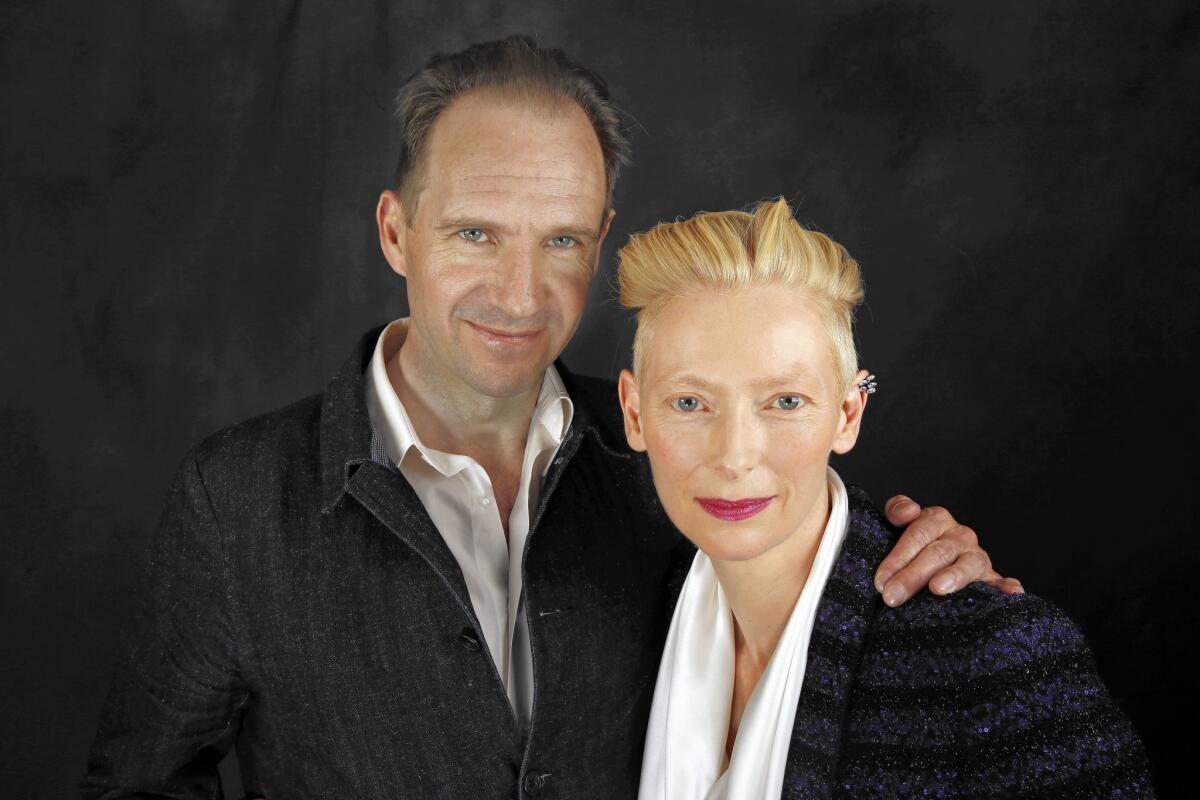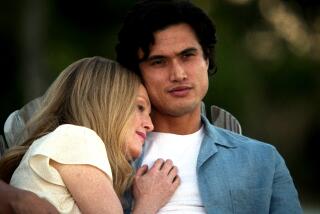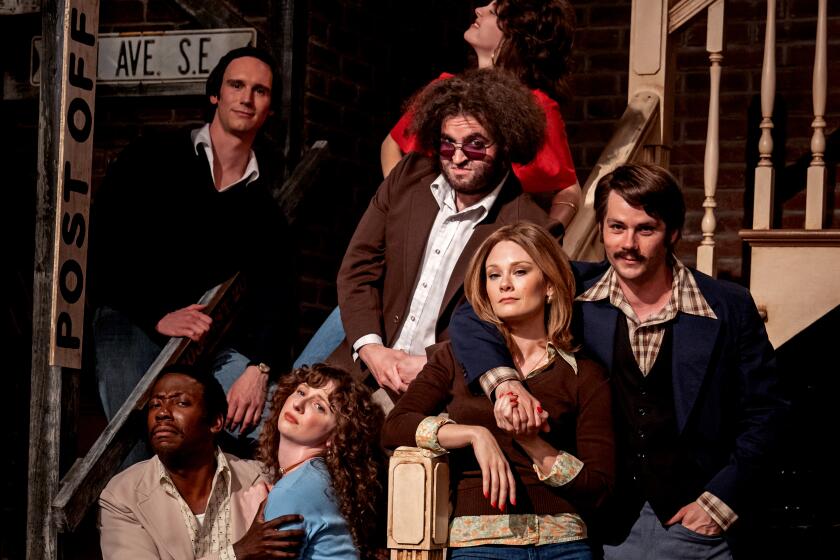Tilda Swinton and Ralph Fiennes celebrate ‘sensational cinema’ with ‘A Bigger Splash’

In the new film “A Bigger Splash,” Tilda Swinton, Ralph Fiennes, Matthias Schoenaerts and Dakota Johnson star in a tale of emotional intrigues and shifting dynamics amid an idyllic Mediterranean island retreat. As in his international breakthrough, 2009’s “I Am Love,” Italian director Luca Guadagnino shoots spaces, bodies, clothes (or the lack thereof) and most of all food with a tactile vitality. Fruit gushes, skin glistens, water ripples, limbs connect, the ricotta is homemade, and the salt-crusted cod looks fantastic.
“I call it sensational cinema. Not sensationalist cinema but a cinema of the senses,” said Swinton, who also starred in “I Am Love.” “I keep joking we should give people sunscreen with their popcorn for this movie. There’s a feeling that you’re going to this place.”
“I keep joking we should give people sunscreen with their popcorn for this movie. There’s a feeling that you’re going to this place.”
— Tilda Swinton
In the film, worldwide rock star Marianne Lane (Swinton) is on the island of Pantelleria with her boyfriend, Paul (Schoenaerts), as she recuperates from a throat procedure that has for now left her unable to speak except in a hoarse rasp. Harry (Fiennes), flamboyant record producer and Marianne’s former flame, arrives unexpectedly with the studiedly enigmatic Penelope (Johnson), a daughter he only recently connected with. The dynamics among the four become a series of unstable plates, with desire, jealousy, class, nostalgia and renewal all colliding.
“A Bigger Splash” is a loose remake of the sexy, stylish 1969 French film “La Piscine” directed by Jacques Deray, which starred Alain Delon, Romy Schneider, Maurice Ronet and Jane Birkin all on holiday at an estate in the South of France.
“The demonization of the remake is quite overrated,” Guadagnino said. “I don’t see why the idea of making a movie from a text that comes from cinema is any different than the making of a movie from a novel, an article, an idea or conversation. It’s really about the point of view to me, that is the most important thing.”
Guadagnino says he saw the original film when he was a teenager, but when he tried to watch it for the new project the disc he had would only play without sound and he gave up after about 20 minutes. After screenwriter David Kajganich watched the movie before his first meeting with the director about the project, he had to admit he kind of didn’t get it.
“Luca’s response was ‘That’s exactly what I was hoping you would say,’” Kajganich said.
The pair began to work on an idea that would transplant the story to the island of Pantelleria, in between Sicily and Tunisia. Guadagnino had been there on holiday while a teenager and though Kajganich had never been there when he was writing, he did extensive research. The duo compiled a matrix of references that included Truman Capote, the Rolling Stones, Claude Chabrol, Douglas Sirk and the Coen Brothers.
“We wanted to get away from the rarefied air of St. Tropez and put it somewhere more problematic, to be honest,” Kajganich said. “Pantelleria is such a specific place, it has this dual personality. On the one hand it’s a vacation spot for people like Giorgio Armani, and it’s the first hurdle for refugees getting from North Africa to Europe. And it’s these two places at the same time. It was an interesting piece of land to put these four characters on and see their subtext become the text.”
The film also reunited Fiennes and Swinton after their appearance in Wes Anderson’s 2014 film, “The Grand Budapest Hotel.” Though their pairing there, as a fastidious hotel manager and an aging dowager, was extremely memorable, they actually shared only a few moments of screen time together.
“I think people remember it because the scenes were well constructed and positioned to set the rest of the story,” Fiennes said, “But I think it was two days I had with Tilda, it was very brief. This was much more involved in terms of the scenes and the physical contact, the emotional contact. It was completely different.”
Fiennes’ performance in “A Bigger Splash” is unexpectedly high-energy — including a show-stopping dance to the Stones track “Emotional Rescue” — as the actor plays Harry as an anxious, agitated motor-mouth who never lets up. His talky turn plays in strong contrast to Swinton, who apart from a few raspy lines, is silent throughout the film, playing her part with the facial and physical expressions of a silent film actress.
The idea to have Marianne rendered more or less mute came from Swinton herself, with Kajganich retrofitting the script to the idea.
“Initially I was disconcerted,” Fiennes said. “I’d been studying a script whereby she spoke to me. And then suddenly she wasn’t.”
Fiennes admits he soon came around to the idea, however. Fiennes and Swinton were playing two people with a lot of implied backstory, a shared history, but who were now in very different places in their lives.
“I’ve spoken before of being interested in stories in which somebody reaches a wall in their life and has to undergo a transformation of some kind,” Swinton said. “But this time is different, [Marianne has] made that decision, she’s gone through the wall and is on the other side and is out there high and dry in her new life. And the old life comes knocking again.”
Just as the dynamics among the characters are a mix of ages and temperaments, so too did the cast itself include a mix of experience and backgrounds. For Johnson, the young American actress best known for her work in the “Fifty Shades of Grey” adaptation, the chance to work with actors such as Swinton and Fiennes was an opportunity she couldn’t pass up.
“I’ve never worked with anyone like Ralph, he’s such a classically trained actor,” Johnson said. “He has a real process, it was like watching some sort of athlete warm up. It was bizarre to me because I kind of fly by the seat of my pants in this industry, and I have zero training and no background.”
The two share a sultry barroom karaoke duet on the song “Unforgettable” that dances along the line of inappropriate for a man and his daughter, even if they have only recently met. The preparations for the scene further highlighted the difference in how they both work.
“I was like, ‘Oh, it will be like karaoke, we’ll just kind of do it on the day and see what happens and try to do our best and they’ll fix it in post,’” Johnson said. “But he had a vocal coach come to the island to work with the both of us and a dance coach to figure out how we should move our bodies. It was hilarious to me, and also amazing and so helpful.”
Guadagnino is set to soon do another remake: He’s taking on Dario Argento’s 1977 horror masterpiece “Suspira,” with Kajganich again writing and Swinton and Johnson to star. “A Bigger Splash” — renamed for a painting by David Hockney — is an observant, detailed study in the great messes people can make while trying to move forward in their lives.
“I want to film the invisible,” Guadagnino said. “One of the invisible things that became visible is the great bond between Marianne and Harry. And not just by dialogue that addresses the notion but by behavior. And the performances of Ralph and Tilda were a joy for me to behold.”
Follow on Twitter: @IndieFocus
ALSO:
Check out our complete summer movie guide >>
‘Doctor Strange’ co-screenwriter defends controversial casting of Tilda Swinton
With ‘Captain America: Civil War,’ Sebastian Stan crosses over from parts unknown
More to Read
Only good movies
Get the Indie Focus newsletter, Mark Olsen's weekly guide to the world of cinema.
You may occasionally receive promotional content from the Los Angeles Times.








